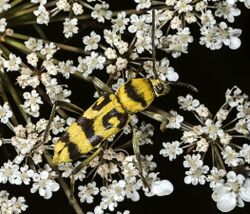Biology:Chlorophorus varius
| Chlorophorus varius | |
|---|---|

| |
| Scientific classification | |
| Domain: | Eukaryota |
| Kingdom: | Animalia |
| Phylum: | Arthropoda |
| Class: | Insecta |
| Order: | Coleoptera |
| Infraorder: | Cucujiformia |
| Family: | Cerambycidae |
| Genus: | Chlorophorus |
| Species: | C. varius
|
| Binomial name | |
| Chlorophorus varius (O.F. Müller, 1766)
| |
| Synonyms | |
| |
Chlorophorus varius, the grape wood borer, is a species of beetle in the family Cerambycidae.[1]
Taxonomy
It was described by O.F. Müller in 1766 under the original name of Leptura varia.[2]
Subspecies and varietas
Subspecies and varietas include:[3]
- Chlorophorus varius damascenus Chevrolat, 1854
- Chlorophorus varius varius (O.F. Müller, 1766)
- Chlorophorus varius varius var. incarnus Plavilstshikov
Distribution
This species is present in most of Europe (except the north) (Albania, Austria, Belarus , Bulgaria, Corsica, Croatia, Cyprus, Czech Republic, France , Germany , Greece, Hungary, Italy, Latvia, Malta, Montenegro, North Macedonia, Poland , Romania, Serbia, Slovakia, Slovenia, Spain , Sweden, Switzerland , Ukraine ), Caucasus, Transcaucasia, Turkey, North Iran and in the Near East (Egypt, Israel, Jordan, Lebanon, Syria).[4][5]
Habitat
These beetles mainly inhabit sunny meadows and woodland edges, at an elevation of 60–800 metres (200–2,620 ft) above sea level.[5]
Description
Chlorophorus varius can reach a body length of 8–14 millimetres (0.31–0.55 in).[6] The body of these beetles is elongated and rather variable in coloration and markings (hence the Latin species name varius). It is covered by a yellow-greenish pubescence, more rarely gray or whitish. The male has longer antennae (reaching mid-elytra) than the female. The pronotum is barred by a black band, sometimes limited to three black spots. The pronotum and elytra have the same width. Elytra are matt, with a C-shaped black marking and two other transversal wasp-like black bands. Legs and antennae are dark brown. Larvae reach a length of about 15 mm.[7]
Biology
Adults can be found from May to September.[8] They feed on pollen and nectar of various flowers, especially of Apiaceae. The life cycle lasts 2 – 3 years.[6][7] Larvae are saproxylic, mainly developing in the wood and dead branches of deciduous trees and shrubs (Vitis, Acer, Quercus, Populus, Malus, Crataegus, Juglans, etc.), sometimes of conifers.[5][9] Pupation occurs in spring in the wood.[5]
Gallery
References
- ↑ Bezark, Larry G. A Photographic Catalog of the Cerambycidae of the World .
- ↑ Müller, 1766, Melang. Soc. R. Turin, 3 p. 188
- ↑ Biolib
- ↑ Fauna europaea
- ↑ 5.0 5.1 5.2 5.3 IUCN
- ↑ 6.0 6.1 "Web Citation". http://www.cerambyx.uochb.cz/chlorvar.htm.
- ↑ 7.0 7.1 Agri.huji
- ↑ Inaturalist
- ↑ GBIF
External links
- Beetles and coleopterologists
- Insektenbox(in German)
Wikidata ☰ Q1755377 entry
 |





